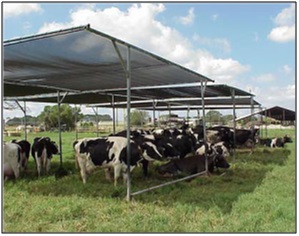Livestock Shade Structure

Description
A livestock shade structure is a permanent or portable framed structure to provide shade for livestock that are adversely affected by heat from the sun or are excluded from natural shade. Shade structures can provide comfort for livestock in areas that are distributed throughout a pasture area, helping to keep livestock from seeking shade from trees in sensitive riparian areas. This protects riparian vegetation and water quality by helping to prevent erosion and animal waste deposition near surface waters. Shade structures are often used in combination with fencing and other practices that may prevent livestock from access to shade from trees.
A livestock shade structure can be constructed permanently or as a portable unit. The structure is generally wood or steel pipe and supports an ultra-violet protected polypropylene fabric (shade cloth) designed to provide at least an 80 percent shade level.
Portable units should be built on skids to facilitate movement and should be sized for practical relocation. An individual portable unit should not be larger than 25 feet by 42 feet.
The amount of artificial shade is dependent upon the amount of natural shade available and the type of animal. An NRCS technician can help determine the amount of shaded area to be constructed.
Livestock shade structures should be located:
- on well-drained sites;
- no less than 200 ft. from any water source;
- at least 150 ft. from an up-gradient well;
- at least 300 ft. from a down-gradient well; and
- at least 50 ft. from any building or structure that would obstruct the circulation of air.
Proximity to livestock water, minerals and shade structures should be strategically planned so as to create a desired livestock-grazing pattern.
The long axis of the shade structure should be generally oriented in the north-to-south direction to keep the shaded area as dry as possible. If animals are confined under the structure, an east-to-west orientation is more desirable.
Operation and Maintenance
Properly constructed livestock shade structures can last for years. However, the fabric of temporary/portable structures will eventually degrade due to environmental conditions and need to be replaced. Storing the fabric during the winter months can extend the useful life of the fabric. The fabric should always be kept tight so that it will not be damaged by wind. Portable structures must be moved periodically to prevent destruction of vegetation.
References
NRCS AL Conservation Practice Standard. Livestock Shade Structure - Code 717
AL NRCS Job Sheet . Heavy Use Area Protection - AL561